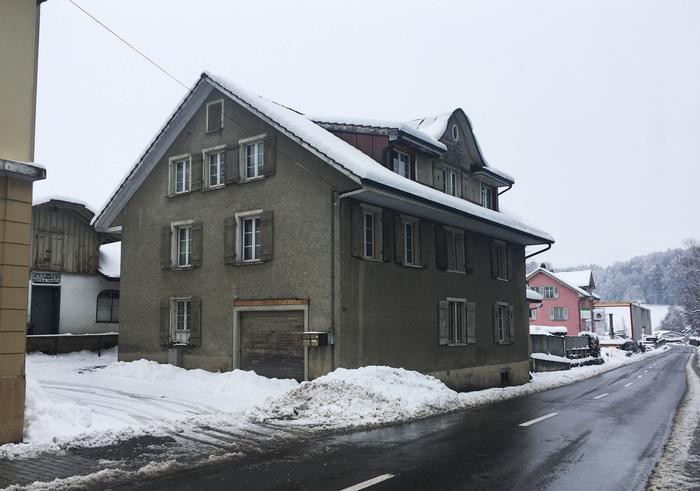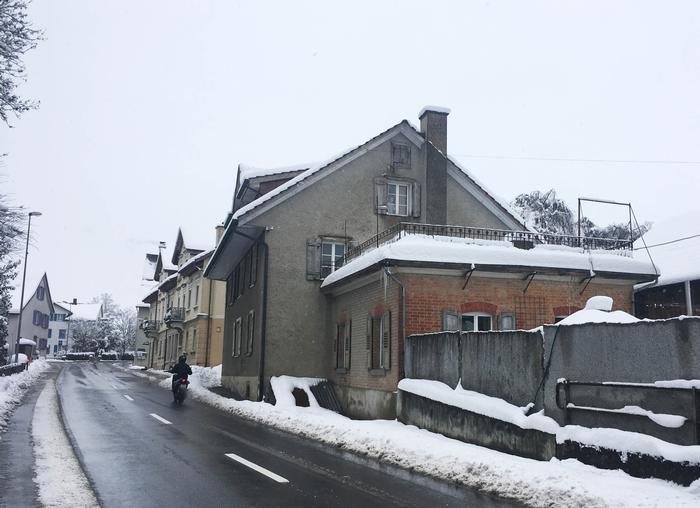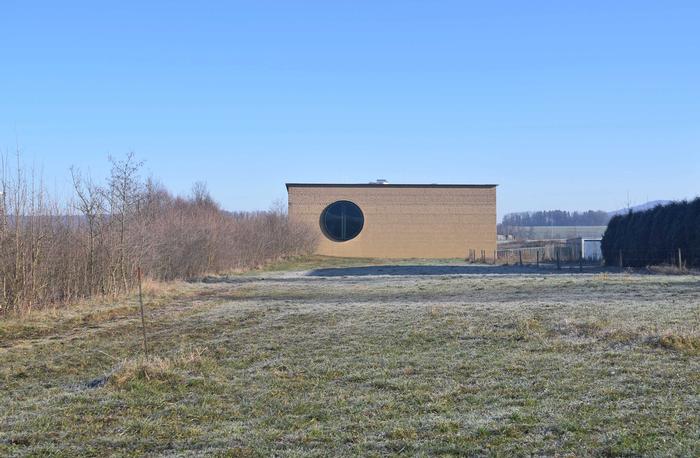[ID:3178] Architecture for the Climate: Swiss Roots in Earth.Germany The construction industry in Switzerland is booming. In the frenzy to provide the fast growing population with much needed new housing, old houses with the slightest sign of decay, or in any way failing to fulfil the high efficiency or aesthetic standards which are expected, are quickly replaced. It takes a walk in a sleepier corner of the country which is not yet strongly affected by the demolition trend, such as the community of Hauptwil, to find a house such as the one at Sornthalstrasse 5.
When walking towards Sornthalstrasse 5 from the central station, the house swings into the street as if it is eager to greet you, as a result of being the only house not aligned to the road. Compared to the smartly painted residential row houses that neighbour it, this house immediately strikes you as being from a different time. One reason are the windows, whose small panes are separated by glazing bars and which are flanked by primitive wooden shutters. The rough brown plaster on the outside walls give the house a rugged feel. This is exacerbated by an exposed brick lintel that was clearly added later in the house´s life to the large shop entrance that resembles a garage door. However, the elegant curve of the roof of the dormer, the rhythmical alignment of the façade and the pleasant proportions of the house in relation to itself as well as to the lot it stands in, still allow the building to appear refined. The house stands a handful of metres off from the row houses next to it, leaving a large enough opening to draw you intuitively around to the back of the house before you wonder about the missing front door on the street side. Discovery of the main entrance to the residence behind the house brings certainty that the house must predate the street.
In fact this house, which was originally a cheese factory, was built in 1863. It’s resistance against the demolition that has made such old houses so rare in Switzerland, is in itself a feat of architectural resilience. Originally, the ground floor of the house contained a cheese factory and shop. These were connected to the living quarters of the owner’s family by only a stairway from the small entrance hall behind the front door. This allowed the house to later be conveniently converted into a two family apartment house with a generous maisonette apartment on the two top floors. The most notable change was a brick extension on the ground floor. The contrast between the light, lofty appearance of the extension with its higher, arched windows and modern, ventilated window shutters to the old wing is striking. Next to the thick walls and low ceilinged rooms of the latter, the extension gives the impression of a summer pavilion. In fact, thanks to the insulation behind the fragile layer of brick perceived from the outside, the extension is used as a living room all year round.
However, on a cold winters day, walking in through the front door set deep in the thick walls of the old wing of the house to the warm interior is a uniquely pleasant experience. This attests to a stunning feat of durability of the walls, which have helped keep the temperatures within the house agreeable for over a century, without extra insulation. They were constructed of rammed earth using the traditional method called “Pisé” in Switzerland. In this method, wet earth is poured in layers into reusable wooden shutterings and then compressed. This is repeated until the desired height of the wall is reached, then the shutterings are removed and the wall allowed to dry.
This method first came to Switzerland from France in the 17th century and quickly gained popularity as the composition of earth found in Switzerland tends have a suitable composition for Pisé. Using the material was not only extremely cost effective, but also required only a single skilled professional to explain and oversee the implementation of the technique by laymen. By nature, the method was extremely sustainable, as the building material often came from the building site itself and contained few pollutants. Because of its extremely low thermal conductivity, it very successfully prevented the loss of heating energy in winter months, while the thermal mass of the thick walls kept buildings comfortably cool in summer. It was durable, but completely biodegradable and therefore left no waste in case of demolition. The only thing preventing perfect symbiosis with the moderate swiss climate was that the work could only be done during the warm, drier months between May and September and had to pause when it rained. Furthermore, the method was very labour intense and the complex shuttering system could produce accuracy problems.
These limitations caused the popularity of Pisé to flux. Several technological advancements were made in the field, such as prefabricated Pisé elements called “Nouveau Pisé”, until, during industrialisation in the 20th century, the shutterings used for Pisé were tried out on the new material on the market. Cement soon phased out earth as a building material, and little technological advancement has been made in the field since.
Only as recently as the last decade, Switzerland came just short of a revival of building with clay. Amongst the several earth buildings built using the traditional Pisé method is the Ricola Kräuterzentrum (Herb Center) in Laufen by Herzog and De Meuron Architects. The 111 metre long and 11 metre high block consists of rammed earth walls on a concrete frame. It stands monumental in a flowering meadow; the otherwise closed façade features only one enormous round window cut out at different heights on each side. The 45cm thick earthen walls are built of rammed earth blocks prefabricated close to the building by earthen architecture specialist Martin Rauch, using earth from within 8 kilometres of the site.
The Kräuterzentrum is used for the processing of dried herbs for Ricola products, and the company, which is known for natural products sourced from sustainable agriculture, wanted this to be expressed by the building. On a sunny day, a touch of the earthen wall foreshadows the experience to come inside the building: unlike every other surface that has been warmed up by the sun, the wall remains cool. Stepping in to the building is like stepping in to another atmosphere. The moderate temperature kept constant throughout the year has nothing to do with the weather outside. The fresh smell of herbs pervades the air, and one immediately feels the increase in humidity which is kept constant at about 50 percent by the clay , which is optimal for herb production. This natural regulation of temperature and humidity combined with a heat recovery system installed on the building which stores the excess heat from the machinery in summer and uses it for the extra heat required in winter results in a building that uses a minimal amount of energy.
Another purpose of the building is the sensitisation of the public to the topics surrounding sustainability that are so important to Ricola . This was incorporated into its design by placing one of the large windows at a suitable height for visitors to the site to view the production process of the herbs. A viewing platform above the middle section of the production hall can be accessed during guided tours of the building. After one of the tours, it is possible to sit in the seats set out for the workers’ breaks behind the building, sheltered from the sun which can be sweltering at the height of the swiss summer, and enjoy the rolling green meadow landscape which the building blends so well into.
Such hot days in which people need shelter from the sun have become more common even in Switzerland, whose climate has historically been very moderate, as climate change causes temperature extremes to increase around the world. The most affected region are the delicate Swiss Alps, where melting glaciers and disappearing permafrost have already begun to cause concern over flooding and rock slides. This is one of several changes; another is increased dryness, which is damaging to agriculture in summer and receives much attention in winter, as traditional winter sports are hampered by lack of snow.
The building industry is a big contributor to the production of greenhouse gasses that are the main cause of global warming. This is due to the energy consumption of the buildings, but also, as new buildings are constantly being built, to the grey energy of building materials used. The earth used for the walls of both the house in Hauptwil and the Ricola Herb Center embodies an extremely low amount of this unit of assessment which comprises the energy that goes in to the production, transport and processing of the materials a building is made from. Furthermore, a large amount of waste is produced in the construction process of most buildings, starting from the excavation material from the building pit. This is often transported at great energetic expense to landfills, which are becoming scarce. Using this material extracted from building sites for the buildings is therefore a win-win solution.
Another problem is the large amount of waste materials from buildings which are demolished. Building with a natural material such as clay greatly reduces the amount of non-degradable waste left over after a building is torn down. Another way to avoid waste from discarded structures is to build resilient buildings, such as the house in Hauptwil. Although it has the capacity to return to dust leaving a minimum amount of evidence of its own existence, it’s adaptable floor plan, pleasant interior climate and exterior aesthetics has seen it preserved to continue providing a habitat and shelter for human activity for well over a century.
Although they contrast each other, the aesthetics of both the house in Hauptwil and the Kräuterzentrum are typical of Swiss architecture. The house in Hauptwil was built when the tradition of pisé was still young in Switzerland and villages were still reminiscent of the middle ages. The house was built on the model of the grand houses found only in France at the time, and many of the elements which were new to Switzerland then were incorporated in to Swiss architectural tradition. Elements such as a small round window in the dormer are familiar to people in Switzerland today, which adds to the aesthetic appeal that contributed to the resilience of the house.
Such a round window, which can be found in many older buildings in Switzerland, is one of the reasons why the Herb Center fits so well into the Swiss cultural context, despite the massive shift in scale. Another is it’s monolithic façade, which is typical of modern Swiss architecture. It’s recognition as being representative of Swiss culture is part of the reason for the popularity of the Kräuterzentrum. Furthermore, the façade lends itself well to the heavy, unwieldy material clay. The reduced window surface area reduces the amount of surface through which unwanted exchange between inside and outside atmosphere occurs, such as heating up of the interior by sun rays, and increases thermal mass- both of which are favourable for the preservation of a pleasant interior climate.
Local architectural traditions were drawn upon for the design inspiration of each of these buildings, which serendipitously in the former case and intentionally in the latter helped to arm them against the negative effects of the climate. This is unsurprising, as the knowledge systems that created and nurtured these traditions are the cumulative results of centuries of human interaction with their environment. In the words of Driss Ketani, a Moroccan Architect whose buildings benefit strongly from the Moroccan building traditions incorporated into them: "When you're building in a specific climate in a place with strong heritage, you can just walk in the street and see the answers. It's just logic."
Of course, these knowledge systems can only continue to prosper if they are constantly improved upon. What makes the Kräuterzentrum a milestone for Swiss earthen architecture is that it is the first rammed earth building in which prefabrication was used at such a large scale. Although this also made it possible to reduce the amount of labour required for the building, it is still higher than that which is required for more conventional buildings. This is one disadvantage of the building method. It is therefore still necessary to improve upon the production chain of rammed earth buildings, if they are to regain popularity on the conventional building market. This will only happen as long as the value of the building material is appreciated.
In the same way that I believe the biggest success of the house in Hauptwil is its resilience which allows it to serve as a reminder and shining example of this building tradition’s staying power, the biggest success of the Kräuterzentrum in my opinion is the resurrection of this tradition which has inspired many architects like myself to consider its potential. Because it is built by world renowned architects, it received worldwide attention, and many people visit the centre, where they learn about the importance of combatting climate change in the building industry and beyond.
The ripple of positive effects started by the Kräuterzentrum has the potential to carry beyond the borders of Switzerland. Every country and climate zone that people have settled in have building traditions with local materials. What particularly drew me to the Swiss tradition of building with clay, whose existence and beginning revival is in fact what drew me to continue my architectural education in Switzerland, is that the same material has a long history in Zimbabwe, my home country. Although the material is ever present there, especially in the rural areas, a lot of stigma is connected to it. People prefer to build with brick or concrete, emulating the better known western building traditions. The example set by a successful Swiss buildings by high profile architects is a contribution to the work that must be done to reverse the stigma the material faces, which would encourage people in Zimbabwe to benefit from and further develop their own local building traditions.
Thinking globally is important in the battle against climate change, as it is this same worldwide problem which causes the increased flooding in Switzerland, drought in Zimbabwe, and hurricanes in the USA. All architects involved in the struggle need to take a more holistic approach to building design, considering all the ways in which buildings contribute to greenhouse gas emissions, starting from the grey energy of the materials used. They may look to local traditions to inspire their designs, to achieve what Dutch architect Bjarke Ingels refers to as “vernacular 2.0”, buildings which benefit from tradition, while appealing to inhabitants of a modern society. Success lies not only in rediscovering traditions, but in digging deeper, resurrecting, and improving upon them using the new technologies available today. Finally, by designing with the intention of bringing awareness and shifting public opinion on the importance of sustainability, they can contribute to the struggle against climate change in the building industry and beyond.
If you would like to contact this author, please send a request to info@berkeleyprize.org. |




